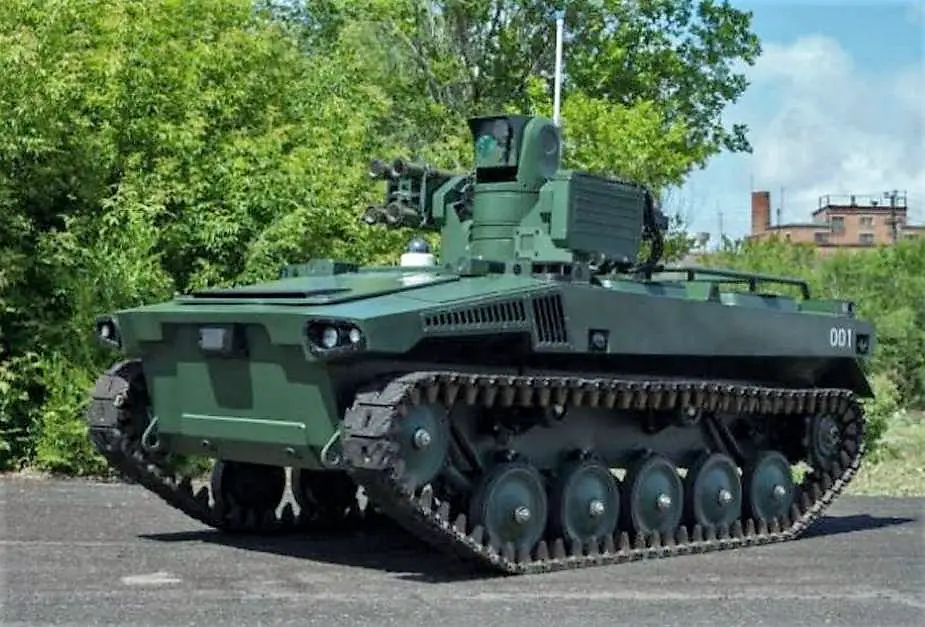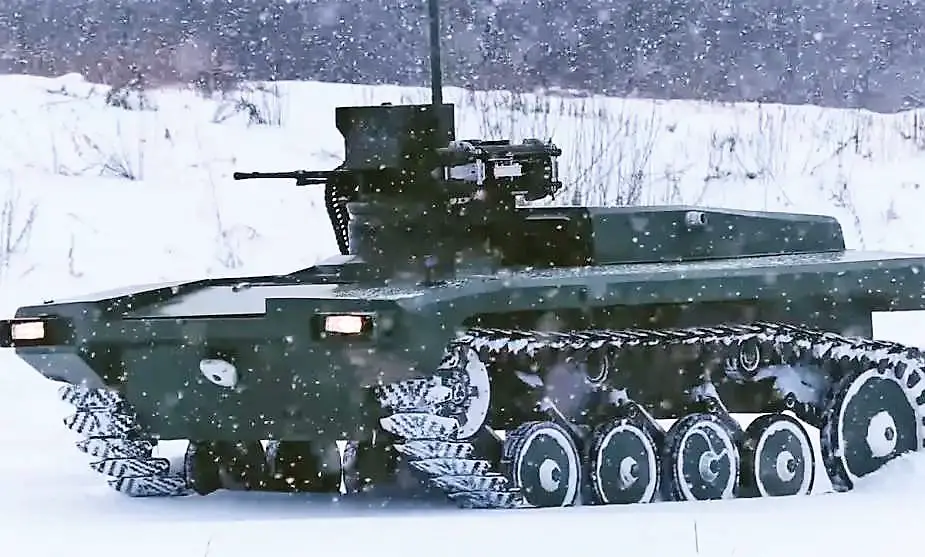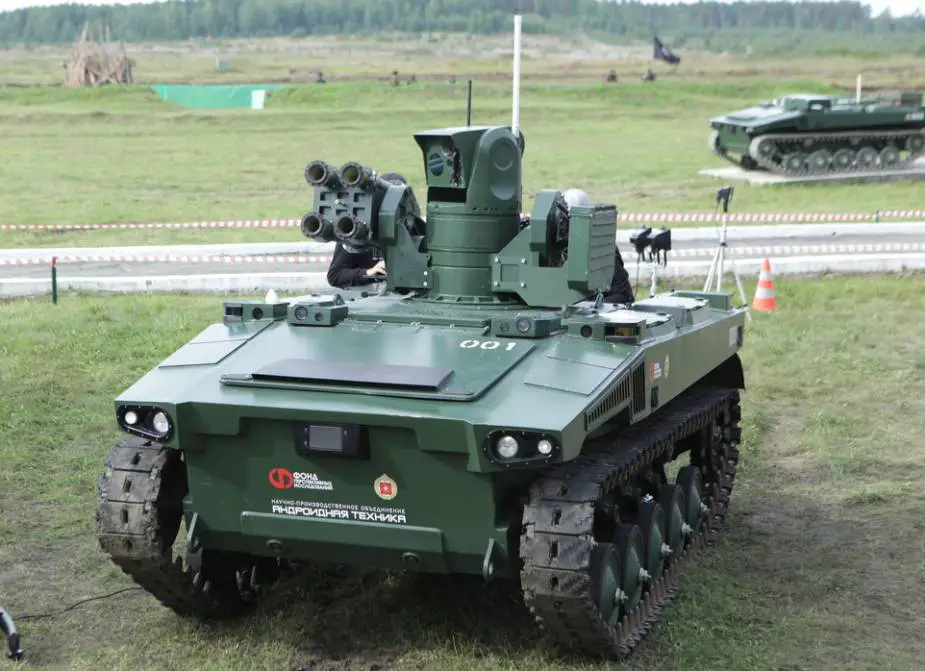Breaking news
Russia will use Marker combat UGVs to burn Ukrainian Leopard 2 and Abrams tanks.
A day after the United States and Germany finally gave the green light to deliver their respective Main Battle Tanks to Ukraine, former Roscosmos director general Dmitry Rogozin said these tanks would be obliterated by a combat robot codenamed ‘Marker’, Sakshi Tiwari reports in EurasianTimes on January 27.
Follow Army Recognition on Google News at this link

The Marker UGV (Picture source: Russian Foundation for Advanced Research Projects)
The former director general of Roscosmos said how his country would fight Western tanks delivered to Ukraine, after Kremlin spokesman Dmitry Peskov’s warning that any tanks sent to Ukraine by the United States would “burn like all the rest.”
The former Director General of Roscosmos and the Head of the special military advisory group known as “Tsar’s Wolves”, Dmitry Rogozin, told RIA Novosti a shock version of the Russian Marker UGV would be deployed in Ukraine in February to obliterate NATO-delivered tanks, Sakshi Tiwari reports. Rogozin explained the combat robot would be able to automatically recognize and attack Ukrainian equipment, including Abrams and Leopard tanks, owing to the computerized catalog of photographs, which means the use of AI (Artificial Intelligence): “The combat version of the Marker robot has an electronic catalog in the control system with images of targets both in the visible range and in the infrared. Accordingly, the robot can automatically determine the enemy’s equipment. For example, as soon as deliveries of the Abrams and Leopard tanks to the Ukrainian troops begin, Marker will receive an appropriate electronic image and be able to detect and hit American and German tanks with ATGMs automatically,” Rogozin said.
Earlier this month, Rogozin wrote on his Telegram Channel that the combat robot would undergo a “baptism of fire” on the battlefields of the Donbas region of Eastern Ukraine. At the time, he said Marker “functions autonomously” to carry out combat operations and locate targets up to 9.3 miles away.
TASS news agency published on January 31 that four Marker robotic platforms are being shipped to Donbass, head of Russian military advisers and of the Tsar Wolves Center Dmitry Rogozin said: “Android Technology Executive Director Yevgeny Dudorov reported that four Market robots are loaded for shipment to Donbass”. The Markers will undergo test operations in the war zone.

Marker UGV during testing in December 2019 (Picture source: Russian Foundation for Advanced Research Projects)
Marker combat UGV
The Marker has been designed by the National Center for the Development of Technology and Basic Elements of Robotics and the Android Technics company. Marker is designed to be modular, with open information architecture. One configuration for the testbed arms it with a Kalashnikov-produced machine gun and anti-tank grenade launchers. More armament combinations may be expected to be tested. What deserves to be observed in the video is the way the turret on the robot tracks a target with the rifle carried by the infantryman. In an official statement from ARF, the agency said the Marker is designed to work “in pair with a fighter, receiving target designation from the sight of his weapon,” or be controlled remotely. So, the Marker would shoot only after the accompanying infantryman has validated the target. But it could operate autonomously if programmed to do so.
A modular multispectral vision and data processing system, featuring neural network algorithms, supports autonomous operations. Other mission systems include a laser warning system, thermal sensors, day/night infrared (IR) cameras, laser rangefinder, target detection, early warning system, identification, and tracking equipment. This generates a new way of cooperation between man and robot where AI-powered sensors take aim and the human checks in before firing. It turns infantry into spotters for robots that will progress on the path of autonomy. ARF clearly sees the Marker as a learning tool, saying “the evolution of combat robots is on the path of increasing the ability to perform tasks in autonomous mode with a gradual reduction in the role of the operator."
The press office of the Android Technics Research and Production Association told TASS that “The Marker robot can be used with various modules and can carry a machinegun, loitering munitions, military and medical equipment, electric rockets, and two types of unmanned aerial vehicles, i.e. tube-launched and towed ones”. Earlier, Head of Russia’s Roscosmos state space corporation Dmitry Rogozin said that the Marker robotic platform had started to patrol the Vostochny cosmodrome. According to him, the Marker operated in remote-controlled and autonomous modes.
Russian enterprise develops module to control several Marker robots simultaneously
A module to control several Marker robotic platforms at a time has been developed, Deputy Head of the Software System Department from the State Scientific Research Institute of Aviation Systems (GosNIIAS) Boris Vishnyakov told TASS: “Our colleagues have developed autonomous motion and motion control modules for several platforms,” Vishnyakov said. According to the specialist, modules for working with equipment, 2D and 3D object recognition, semantic segmentation, depth calculation, automatic self-localization, trajectory building, and passability measurement have been developed.
Markers combat UGV to enter Ukraine battlefield
Rogozin told the media that four Marker robots will be delivered to the Donbas in February, both in reconnaissance and strike versions. First, they will be tested at the training ground and later in combat. Marker has a swivel combat module capable of turning around 540 degrees in just one second. The robot will autonomously select a target according to priority based on which of them is the most significant – and hit it with the appropriate firepower.”
Russia already deployed several Kalashnikov-made robots of different models to support its operations in Syria and eastern Ukraine.

Marker UGV (Picture source: Wikipedia)


























